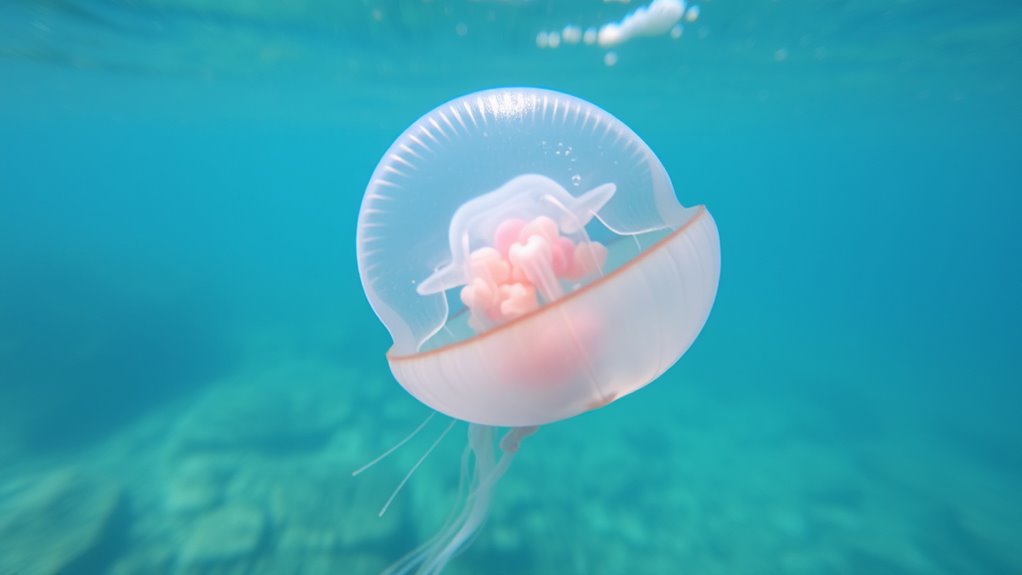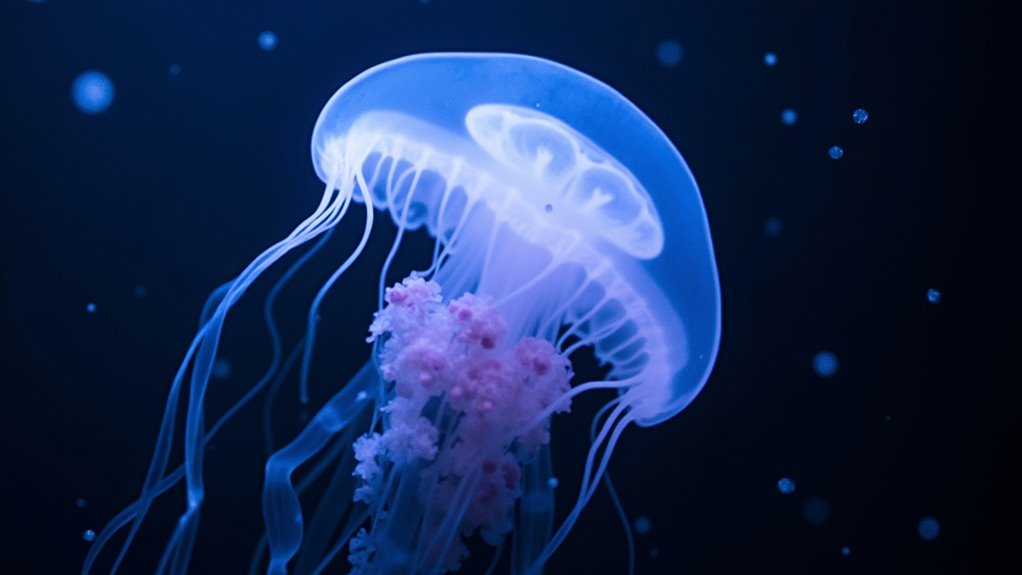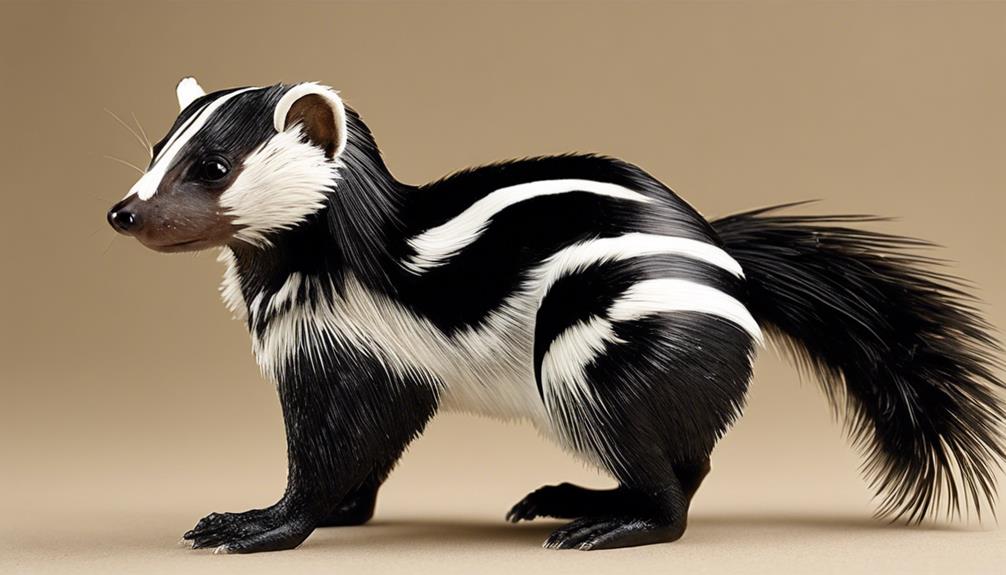Animals without skeletons rely on their flexible bodies, supported by external features like shells, cuticles, or tough outer layers. They use muscular movements, such as wave-like contractions or pulsations, to glide, squeeze, and explore their environment. This flexibility helps them move through tiny spaces, escape predators, and adapt to diverse habitats. If you want to discover more about how these creatures thrive without bones, keep exploring their fascinating adaptations.
Key Takeaways
- Many soft-bodied animals rely on water, cartilage, or tough outer layers for support instead of rigid skeletons.
- Flexibility allows these animals to perform complex movements, squeeze through tiny spaces, and navigate diverse habitats.
- Support features like chitinous exoskeletons or muscular hydrostats provide structural stability without bones.
- Absence of bones grants increased agility, enabling quick escapes from predators and versatile exploration.
- Their adaptable, flexible bodies demonstrate evolutionary advantages in environments where rigid skeletons would be limiting.

Have you ever wondered how some animals manage to move and thrive without a skeleton? It’s fascinating to realize that many creatures, especially soft-bodied invertebrates, have developed unique ways to survive and navigate their environments without the rigid support we typically associate with bones. These animals rely on their soft, flexible bodies, which grant them incredible agility and adaptability. Their ability to perform flexible locomotion allows them to squeeze through tiny spaces, hide from predators, and hunt efficiently—all without the need for bones.
Soft-bodied invertebrates, such as worms, jellyfish, and slugs, have evolved to depend on their flexible structures. Instead of a skeleton, their bodies are supported by water, cartilage, or a tough outer layer called a cuticle or shell. For example, earthworms use their muscular segments to burrow underground, contracting and relaxing their body in a wave-like motion that propels them forward. This flexible locomotion isn’t just effective; it’s essential for their survival in complex environments. Similarly, jellyfish rely on rhythmic pulsations of their bell-shaped bodies, allowing them to drift with ocean currents or move purposefully through the water. Their soft bodies are highly elastic, enabling smooth, flowing movements that would be impossible with rigid structures.
Soft-bodied invertebrates rely on water, cartilage, or tough outer layers for support, enabling flexible and efficient movement in complex habitats.
Without bones, these animals often have a higher degree of flexibility, which translates into more versatile movement patterns. Slugs, for instance, glide along surfaces using a slimy mucus trail and wave-like contractions of their muscular foot. Their lack of a skeleton makes them less susceptible to injury from rough terrain but also means they must be careful to avoid dehydration and other environmental hazards. Many soft-bodied invertebrates also have supportive features like chitinous exoskeletons or tough outer layers that provide structure without the rigidity of bones. These adaptations help them withstand predators and environmental stresses while maintaining their flexibility. Interestingly, their unique body structures demonstrate how evolution can favor soft, flexible forms over rigid skeletons in certain environments.
The absence of bones doesn’t mean these animals are any less successful. Instead, they’ve harnessed the power of their soft bodies to thrive in habitats where rigid structures might be a hindrance. Their flexible locomotion allows them to explore diverse niches, escape predators, and perform complex movements that rigid-bodied animals couldn’t replicate. Adaptive features like muscular hydrostats enable many of these creatures to control their body shape with precision, showcasing a different kind of biological engineering. So, next time you see a worm wriggling through soil or a jellyfish pulsing through the ocean, remember that their incredible flexibility is a testament to how animals can survive and flourish without skeletons. They prove that sometimes, adaptability and movement are more about flexibility than rigidity.
Frequently Asked Questions
How Do Animals Without Skeletons Support Their Body Weight?
You might wonder how animals without skeletons support their body weight. They rely on muscle support to maintain their shape and movement, with strong muscles acting like natural braces. Buoyancy control also plays a key role, especially in aquatic animals, helping them stay afloat and reduce the load on their bodies. Together, muscle support and buoyancy allow these animals to move efficiently and survive without bones.
Can Animals Without Skeletons Regenerate Lost Parts?
Ever wonder if animals without skeletons can regenerate lost parts? You might be surprised! Many of these animals, like sea stars and worms, excel at soft tissue regeneration and limb regrowth. They can often recover from injuries by regrowing missing parts, thanks to their unique cellular abilities. So, yes, despite lacking bones, these creatures possess impressive regenerative powers that help them survive and thrive in their environments.
What Are the Largest Animals Without Skeletons?
You might be surprised to learn that among the largest animals without skeletons, the largest are certain invertebrates like the giant squid and some whale species. These animals showcase incredible vertebrate diversity and rely on unique skeletal adaptations, such as cartilage or fluid-filled bodies, instead of bones. Their size demonstrates how animals without traditional skeletons can still thrive, adapting creatively to their environments and challenging our understanding of vertebrate diversity.
How Do These Animals Defend Themselves Without Bones?
You might wonder how soft-bodied animals defend themselves without bones. They rely on soft body adaptations like flexible, tough skins or slime layers to deter predators. Camouflage strategies also play a key role, allowing them to blend seamlessly into their environment. These animals often use quick movements or release toxins to escape danger, making their soft bodies an advantage rather than a vulnerability in their survival tactics.
Do Animals Without Skeletons Have a Longer or Shorter Lifespan?
You might think animals without skeletons have shorter lifespans, but surprisingly, marine invertebrates often live just as long or even longer than their bony counterparts. Their flexible bodies and unique survival strategies help them thrive in tough environments. In a lifespan comparison, these animals demonstrate resilience, showing that lacking bones doesn’t necessarily mean a shorter life. Instead, their adaptability often becomes their greatest strength for survival.
Conclusion
You might think skeletons are essential for survival, but these animals prove otherwise. Without bones, they embrace flexibility, adapting in ways you never imagined. Their soft bodies, vulnerable yet resilient, show that strength isn’t always about rigidity. In a world where skeletons often symbolize stability, these creatures remind you that survival can also mean softness, fluidity, and adaptability. Sometimes, the most unexpected forms of strength are found in what you don’t see—no bones, no problem.










